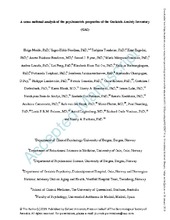A cross-national analysis of the psychometric properties of the Geriatric Anxiety Inventory
Molde, Helge; Nordhus, Inger Hilde; Torsheim, Torbjørn; Engedal, Knut; Bendixen, Anette Bakkane; Byrne, Gerard J.; Marquez-Gonzalez, Maria; Losada, Andres; Feng, Lei; Kuan Tai Ow, Elisabeth; Pisitsungkagarn, Kullaya; Taephant, Nattasuda; Jarukasemthawee, Somboon; Champagne, Alexandra; Landreville, Philippe; Gosselin, Patrick; Ribeiro, Oscar; Diefenbach, Gretchen J; Blank, Karen; Beaudreau, Sherry A; Laks, Jerson; Bom de Araujo, Narahyana; Paz Fonseca, Rochele; Kochhann, Renata; Camozzato, Analuiza; van den Brink, Rob; Fluiter, Mario; Naarding, Paul; Pelzers, Loeki P R M; Lugtenburg, Astrid; Oude Voshaar, Richard; Pachana, Nancy A.
Peer reviewed, Journal article
Accepted version

Åpne
Permanent lenke
https://hdl.handle.net/1956/21852Utgivelsesdato
2019-01-08Metadata
Vis full innførselSamlinger
Originalversjon
https://doi.org/10.1093/geronb/gbz002Sammendrag
Objectives: Assessing late-life anxiety using an instrument with sound psychometric properties including crosscultural invariance is essential for cross-national aging research and clinical assessment. To date, no cross-national research studies have examined the psychometric properties of the frequently used Geriatric Anxiety Inventory (GAI) in depth. Method: Using data from 3,731 older adults from 10 national samples (Australia, Brazil, Canada, The Netherlands, Norway, Portugal, Spain, Singapore, Thailand, and United States), this study used bifactor modeling to analyze the dimensionality of the GAI. We evaluated the “fitness” of individual items based on the explained common variance for each item across all nations. In addition, a multigroup confirmatory factor analysis was applied, testing for measurement invariance across the samples. Results: Across samples, the presence of a strong G factor provides support that a general factor is of primary importance, rather than subfactors. That is, the data support a primarily unidimensional representation of the GAI, still acknowledging the presence of multidimensional factors. A GAI score in one of the countries would be directly comparable to a GAI score in any of the other countries tested, perhaps with the exception of Singapore. Discussion: Although several items demonstrated relatively weak common variance with the general factor, the unidimensional structure remained strong even with these items retained. Thus, it is recommended that the GAI be administered using all items.